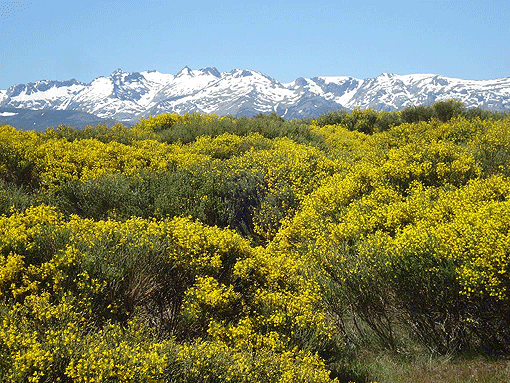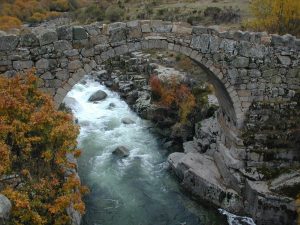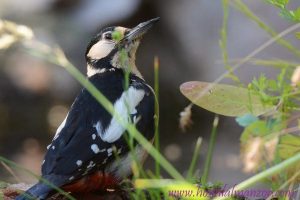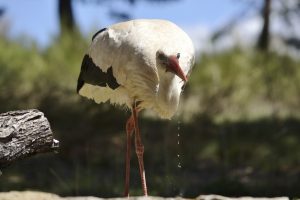
WHAT TO DO IN GREDOS DURING SPRING
In Gredos our greatest treasure is nature, and in spring the possibilities of enjoying it increase. In addition to the routes and activities that it is possible to do all year, in Spring you can witness how the mountain is dyed yellow (Festival del Piorno in bloom) and how the cows return to the fresh pastures of Gredos after winter (The Transhumance). To these extras are added the classics: mountain routes, bicycle, horseback, adventure in the trees (zipline crossing), archery...
The Sierra de Gredos dresses in its best to welcome the spring: a yellow and white blanket covers its rugged hills and a delicious delicious smell floods the air announcing that the harsh winter is behind us ... life returns! , the flower in bloom returns to Gredos…!

The piorno is a humble shrub, of different varieties, covering more than 65,000 hectares of forest and meadows in North Gredos. Its flowering does not have a fixed date, it depends on the year, it is already known that nature does not like limits. However, from mid-May to the first of July it is possible to see blooming brooms, although its peak is usually in June.
Asenorg, association of businessmen of Gredos Norte, organizes for years the "Festival del piorno en flor". Throughout the months of May and June are carried out acts such as contests of decoration of buildings with piorno; signage of more than 60 points to observe the best landscapes, and a large number of activities that have the common protagonist the piorno.If you do not want to miss detail visit: http://www.facebook.com/Piornosenflor.
The transhumance is a thousand-year-old cattle practice that consists of the displacement of the herds in search of better pastures. Thus, the cattle spend the summer in the mountain areas, moving in winter to the pastures of the south of the Peninsula, Extremadura and Toledo mainly.
The passage of the herds of transhumant cows that return from Extremadura to enjoy the fresh pastures of the mountains during the summer is a real and authentic show that can be seen every June in Gredos Norte.
From the top of Puerto el Pico, and through the Roman Causeway, crossing valleys and villages, we can enjoy the vision of this centuries-old tradition: La Trashumancia.
The origin of these towns is not very clear but it seems that they were founded by transhumant cattlemen around the X century.
During the summer months, the cattle remain in communal passages or small pastures typical of the sierra, when the cold and the snows begin, the farmers group to lower the cattle to Extremadura, through royal ravines and twines.
This transhumance supposes a whole rite, subject to a code of honor, which has been transmitted from generation to generation. Each day they travel about 20 km., With more or less fixed itineraries, which end in rest stops where you spend the night.
This same operation, but in reverse (Extremadura-Sierra) is done when the summer days begin. The heads of cattle arrive at the mountain range of Avila, crossing the Puerto del Pico along the Roman road, which is a beautiful spectacle.
The Mesta was the association that for more than six centuries organized the transhumant herdsmen. Throughout this period the "Merino" sheep would be the majority transhumant cattle.
This system allows the cattle to be fed throughout the year of natural grass in extensive regime. This form of exploitation that respects the environment demonstrates that traditional practices are a sustainable model for rural management.
In addition to contributing to the conservation of the environment, transhumance has given rise to an important tangible and intangible cultural heritage that has survived to this day.
The displacements of the flocks were traditionally carried out on foot, although today most are those that use trucks. For the trips on foot it was drawing a dense specific road network that crosses all Spain; they are the ravines, the cordeles and the sidewalks. More than 125,000 kilometers of cattle roads that constitute a valuable public heritage.
The canyons are also an excellent resource to travel and discover the territories where transhumance was the main activity and especially as in the case of Gredos, where it is still common practice.
The transhumance in the Sierra de Gredos is closely related to the avilanian-black Iberian breed, an autochthonous breed perfectly adapted to this type of livestock management. At present, 40,000 cows still make their change of pasture every year. The march of the transhumant herds along the ravines is a real and authentic spectacle.
On your own or with the help of a mountain guide you can make routes of different difficulty from the well-known route of the Laguna Grande to the climb to Almanzor Peak, the highest in the Central System. These are the contacts of the different companies that you can hire if you want to discover the mountain range with the safety of a good guide.
Enjoy Gredos:
Jorge Apausa
Half mountain guide, offers routes through the mountains for all levels as well as orientation courses with compass and map.
More information at www.enjoygredos.com.
Contact: Jorge.
Phone: 687253944. Email: info@enjoygredos.com.
The Axis of the Earth
It offers hiking and nature routes.
They are educational and entertaining guided routes.
More information at www.elejedelatierrra.com Contact: Mercedes Sánchez.
Ejedelatierra@ejedelatierra.com and Mobile: 636307084.
Alpina School of Gredos:
They teach you how to climb, both in rock and ice and offer their services of qualified high mountain guides. More information: 667 63 67 26 / 687078324. Contact: Raúl Lora.
Gredos Guides.
Located in San Martín del Pimpollar, Juanfran offers guided, mycological and ornithological routes.
Telf: 626066223/920348817.
Web: www.gredosguides.es. info@gredosguides.es
Contact: Juanfran.
If you are a lover of Ornithology, Hostal Almanzor is the ideal place to spread your passion:
Information on where to see them.
The only Hide in Spain with direct access from inside the Hostel to observe a multitude of species in absolute freedom (totally free for those staying).
A hide of scavengers in the same farm (previous reservation).
From its Hide, you can enjoy the observation of kites, climbers, coalfish, black whistles, crossbills, Capuchin herrerillos, mosquito nets, goldfinches, jays, scribes, myths and up to 90 different species depending on the time of year. Also mammals like the Fox, Squirrels, etc.
Equitravel.
On horseback by Gredos.
Located in Navarredonda de Gredos, 1 km from the Casa del Altozano.
They offer half-day and full-day excursions, well-trained horses for riders and beginners. And now also excursions in Poni for children.
For more information: www.equitravel.es
info@equitravel.es.
Tel: 635 433 079. Contact: María Elena and Jaime.
Gredos a Caballo:
It is the most veteran company in the area in the realization of excursions on horseback, more than 20 years teaching to enjoy Gredos on the back of a horse. Routes of different duration.
Contact: Rafa. www.gredosacaballo.com.
Tel: 920349085 / 615946026.
Gredos Tormes
In July 2009, Miguel Angel Vida, mountain guide, launched the Adventure Park in the Trees Trees Cimeros. It offers different routes through the trees of an impressive pine grove of pine trees in Hoyos del Espino, next to the Casa del Parque. Currently managed by Gredos Tormes.
For more information: info@gredostormes.com.
Telephones: 920348385.689494929. info@gredostormes.com
Highway of the Platform, 0.2.
Active Gredos
From rental of ice axes, sledges or bicycles to telescopic poles or portable climbing walls, the company Gredos Active offers in addition to the rental of equipment all kinds of activities from archery to paintball through the organization of Gynkanas and a games.
For more information:
Santi Phone: 920 348045.
gredosactivo@gredos.com Ctra.C500, km 40,500. Navarredonda de Gredos.

They do not agree on the exact place of their birth, however, popularly the origin of this river is located in the dehesa of Navapalenciana, in the place known as Fuente Tormella, at 1,580 meters from altitude above sea level, which feeds on filtering waters from the Collado del Cepegato.
Well, this river, cradle of the Lazarillo de Tormes, covers a total of about 250 kilometers to its mouth in the Duero (near Villarino, on the Portuguese border).
Here at its source and as it runs, the Tormes feeds on the waters of the different gorges and torrents, such as the Raven, the Boar, Valdeascas, La Cabrilla, Barbellido, etc.
Following the course of these gorges provides some of the most interesting routes and also the possibility of practicing another activity that was very important in Gredos for tourism in the 70s: FISHING.
"Delight of fishermen and select palates ...", that's how Gredos trout are. Although fishing them is increasingly difficult in the Tormes can be done in areas bounded for it. The delicacy and exquisited of the delicacy is well worth the effort. Permits are obtained at the Parador.
In the house you will find detailed information about the routes, as well as guides, maps, etc.

If you have any contracture, muscle pain, etc., or if you simply want to tone your body and have a relaxing massage, very close to the Casa del Altozano you have the professionals and facilities to do so.
In Hoyos del Espino, 4 km away, you will find the rural Spa Aguas de Gredos, where in addition to massage cabins, body treatments, chiromassage and physiotherapists you can enjoy its hydrothermal circuit and heated pool and jets, etc.
For more information and reservations you can call 920 34 90 47, send them an email: info@aguasadegredos.com, or consult their website: www.aguasdegredos.com
Visit monuments, buildings and emblematic places of Gredoses another option for the traveler.
Parador de Gredos:
Former hunting lodge of King Alfonsso XIII, this historic building was transformed in 1928 into the First Parador de Turismo de España.
Throughout the years, the Parador has become a tourist and economic engine of the area and a symbol of quality and know-how. It was also the place chosen by the "fathers of the Constitution" for the drafting of the 1978 Magna Carta. For all this history it would be worth a visit, but it is also a pleasure to enjoy the magnificent views of the pine forest and the mountains that can be contemplated from your cafeteria and terrace, or if you prefer to taste a dish of its careful Cart
For more information: www.parador.es. Tel: 920348048. email: Gredos@parador.es
Barajas Laundry:
The running water took to arrive to this like to so many towns of Spain. In its place the numerous fountains and "chorrillas" provided the necessary water to drink and wash clothes, becoming, in addition, a meeting place and even instead of a date for lovers.
Practically all the old laundries have disappeared ... those shelters of serranas, tanned in a thousand winters, that by dint of reumas whitened the sleeping clothes in the boats. However, very close to La Casa del Altozano, just over 200 meters away, is one of those old rehabilitated laundry that was still used 40 years ago.
Fraguas:
The origin of these villages goes back to the 10th century, when transhumant breeders settled in the area attracted by the freshness of their pastures and the goodness of their summer climate, remaining in these lands during spring and summer.
To the rear of these cattle settlements, blacksmiths and saddlers were also installed in the urban nuclei that manufactured tools for the home and livestock. Vestiges of their work are the forges, of Roman origin, which are still preserved in most of these mountain villages.
These are still farmers, but the cows are no longer irons because the land is not sown as before. Some horses yes irons but having less work are the itinerant blacksmiths who move to the different towns.
Here in Barajas, next to La Casa del Altozano, there is a Forge, inside which the old bellows still remain. Next to the forge is the "Potro", structure of stone, metal and wood that was used to shoe cows and horses. In Navarredonda, the old forge is transformed every summer into a tourism office.
Church of San Benito Abad (Barajas). Fourteenth century:
Simple but very harmonious temple located in front of La Casa del Altozano, in Barajas. With oriented polygonal head and without decoration nor abutments, the church consists of three naves separated by wooden columns. It has a major altarpiece, with works from the XVI and XVII centuries and a peculiar bell tower of two bodies of different thickness, of sillarejo with ashlar in the body of the bells.
Church of Our Lady of the Assumption. 15th Century:
Located in Navarredonda de Gredos, 300 meters from the Casa del Altozano, this church stands out especially for the strength of its free tower, old watchtower for military use, of singular structure consisting of two bodies of different thickness, of sillarejo with ashlar in the body of the bells. The temple is the work of the Late Gothic and in its interior there are preserved images and polychrome carvings, altarpieces of the seventeenth and eighteenth centuries and numerous canvases.
Cuevas del Aguila:
The Cuevas del Águila were discovered in 1964 on the hill of Romperropas, which would later be called the Eagle, thus changing the name of the cave. Compared by scientists with the famous Caves of Drac, Mallorca, for the great conservation of its interesting geological forms (stalactites, tours, stalagmites, aragonite, etc) the Caves of El Águila are a good alternative as an excursion, especially if traveling with children of school age.
Located in Ramacastañas, at the end of El Puerto del Pico, 35 km from La Casa del Altozano, the Cuevas del Águila are an extraordinary example of a karstic cavity originated by a series of complex geological processes. The route is a 1 kilometer through a large area of about 10,000 square meters, and the duration of the visit, unguided, is about 40 minutes, with a stable temperature always around 20 degrees.
It remains open all year and for more information you can consult the web www.grutasdelaguila.com or on the phone numbers: 660842493 / 920377107.
Museum of bees
Bees of the Valley is a living museum classroom created to bring the incredible world of bees to all audiences safely. It is in Poyales del Hoyo you can visit the Bees of the Valley Museum Classroom.


